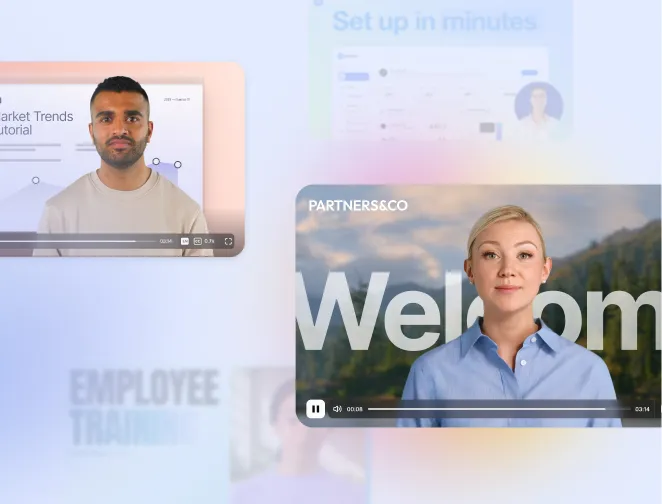
Create AI videos with 230+ avatars in 140+ languages.
Artificial Intelligence is transforming the way we learn.
And, by definition, the way we teach.
In this post, we'll explore the benefits of artificial neural networks and how they have been used to create software that speeds up both your workflow and the professional development of your employees.
Because no matter how clever AI gets, human intelligence will always be number one.
Keep reading until the end for 5 in-depth examples of how real companies use AI to get typically unheard-of results!
Why AI is an excellent tool for L&D training programs
There are a few key benefits to using AI to facilitate deep learning and improve your learning processes.
For the learner, your employee, AI helps:
- Deliver a more personalized learning experience.
- Speed up the delivery of information by democratizing content on learning management systems that are easily accessible worldwide. This also aids reinforcement of learning goals.
- Customize video content to form a more personal one-on-one connection.
For you as an L&D professional, AI can help:
- Speed up the learning process and increase completion rates. A UCL study found that training courses with AI videos were completed 20% faster than traditional methods, with recall and retention matching videos made with real actors.
- Provide personalized assessment techniques, eliminating the need for traditional evaluation methods.
- Translate training materials into multiple languages, making them accessible globally and speeding up the learning process.
- Free up time spent developing content by becoming digital tutors.
But first: Getting your team on board
Here's the truth: the biggest obstacle isn't the technology, but getting your team excited about using it. Research shows that teacher and trainer motivation represents the biggest challenge for AI adoption in learning environments.
I've seen this play out dozens of times. The L&D teams that successfully adopt AI for employee training share a few common approaches:
- Start with hands-on trials: Let your team experiment with AI tools on low-stakes projects first. When they see how quickly they can create professional content, skepticism turns to enthusiasm.
- Demonstrate clear value: Show how AI handles the tedious parts—like updating content across multiple languages—so your team can focus on instructional design and learner engagement.
- Customize to their context: Connect AI capabilities directly to your team's specific pain points. If they're struggling with consistency across global offices, lead with multilingual features.
- Address concerns openly: Be transparent about what AI can and can't do. This builds trust and sets realistic expectations.
Now that we've covered the benefits and how to get buy-in, let's look at the practical tools you can start using today.
The 2 types of AI you can use for corporate training right now
1. Turn text-to-video in 5 steps
You might have heard of text-to-speech tools that read out something written. Or transcription tools that take can turn speech into text...
But text-to-video really takes L&D programs to the next level.
AI video maker tools such as Synthesia can create both a voice-over and a human avatar from just a bit of written text. This means with a script, you can create professional video training that keeps employees more engaged.
Check out this video to see how it works:
2. Turn thoughts into written scripts using NLP
One of the coolest applications of AI in content creation is Natural Language Processing (NLP). Basically, NLP is a way for computers to understand human language and use it to generate new written content.
In content creation, an NLP AI model uses data collection to analyze language patterns, identify key themes and ideas, and generate written content that meets specific requirements.
Here's how NLP can help automate scriptwriting for videos and audio content:
- Write starter draft scripts for video content based on a subject
- Generate ideas for training videos
- Improve the way your draft script is written by making it concise or punchy
- Generate lists of best practices or tips that you can use in your videos. It can even identify common knowledge gaps that you can then use to create more robust L&D programs!
To start writing a script with AI, we recommend using a tool like ChatGPT or our AI script generator.
Your initial input needs to help the AI by stating the topic, the audience, and the tone of voice. For example, "write a script that teaches corporate employees what data science is, and what data scientists do. Please make it sound friendly and approachable."
Here's an example of a result you might get:

Measuring what actually matters
Let's be honest - completion rates don't tell the whole story. I've worked with companies celebrating 95% course completion while their actual performance metrics stayed flat. The real challenge is connecting training to business outcomes.
Here's the measurement framework that actually works:
- Completion rates: Your baseline metric, but just the starting point
- Knowledge retention: Test understanding 30, 60, and 90 days post-training
- Skills application: Track whether employees use new skills in their daily work
- Business outcomes: Connect to real KPIs like customer satisfaction, error rates, or sales performance
5 inspiring examples of how companies have used AI to drive results
Case Study #1: How Bosch developed 70% more effective training
Bosch is a leading European company in the home appliance industry, with more than 60,000 employees worldwide.
The challenge
Bosch faced a challenge in ensuring that every employee had access to the necessary knowledge, given their worldwide spread. The company turned to video production to address this but found it expensive, inflexible, and not easily accessible to specific groups.
The solution
The L&D team piloted Synthesia. The team created bite-sized scripts, chose an avatar from Synthesia's library, and added images and screen records to the in-built slides. Now, training videos were easy to create, update, and translate into different languages (using features like Smart Updates and 1-Click Translation).
With Synthesia, Bosch was able to create training materials that were effective, efficient, and accessible to all employees.
The results ⏱️💰
The impact of Synthesia was significant. Bosch saw a 70% reduction in external video production costs, a 30% increase in engagement, and over 30,000 web views.
Virtual training like this is a great representation of professionalism. We are on the right track. I'm happy to be able to provide something so great for our end users worldwide. - Dennis Hein, Head of Global Planning and Logistics
Case Study #2: Bestseller cut 50% classroom time with AI video
The challenge
Bestseller faced challenges with their video training, including untrained cast, inflexibility for updates, and difficulty in scaling due to lengthy filming and production times.
The solution
Bestseller overcame these challenges by implementing Synthesia. The team is now empowered to create short, efficient training videos from their desks, and even convert classroom content into prep videos. With Synthesia, the process is quick and easy; they simply input the script, choose an avatar, make edits, and generate the video for upload to the Learning Experience Platform.
The results ⏱️💰
Synthesia videos have reduced participant classroom time by 50%. Additionally, the Bestseller team has cut their video production time in half.
We consistently get great feedback. Usually, our colleagues don't jump in the air when they hear e-learning, but the AI videos have sparked motivation that we haven't seen before. — Sidsel Skov Kragsnæs, Digital Learning Specialist at BESTSELLER
Case Study #3: How Beyond Retro scaled its retail operation training
Beyond Retro is a vintage clothing retailer store in the UK and Sweden.
The challenge
Beyond Retro needed to quickly upskill their salespeople to take over 80% of the store's responsibilities due to downsizing caused by COVID-19. The training process had to be timely and scalable as they planned to expand with new stores.
The solution
Beyond Retro quickly created training courses for their employees. They followed these 6 steps to develop practical training courses:
- Business managers drafted the initial scripts
- The L&D manager reviewed and edited the scripts accordingly
- The L&D team used Synthesia to turn the script into a video
- The video was reviewed by the business managers
- The L&D team made any necessary changes
- The final video was generated and shared with the team
The results ⏱️💰
The Synthesia solution helped Beyond Retro to:
- Release an entire course in just 2 weeks.
- Upskill 140 employees.
- Expand training to 3 new markets.
I feel like Synthesia enabled me and my team to do so much more and truly impact the business at scale.— Ashley Emerson, L&D Manager at Beyond Retro
Case Study #4: How Screenloop scaled interview training with Synthesia
Screenloop is a London-based hiring intelligence start-up aiming to make better hires with unbiased data.
The challenge
Screenloop aimed to fill the knowledge gap in the market by providing practical interview training to professionals. However, they wanted to avoid traditional video production's high costs and time delays, such as hiring actors and editing staff.
The solution
To find an efficient alternative, they turned to Synthesia. Using Synthesia's AI technology, Screenloop created training videos in five simple steps:
- Creating a script
- Inserting it into Synthesia's script box
- Selecting an AI Avatar
- Adding graphic elements
- Generating the video
Check out what the end result looked like in the video below:
The results ⏱️💰
A 500% video budget savings and savings of £1,700 per video compared to traditional video creation. Furthermore, it took only five days to finalize a video using Synthesia.
Synthesia played a major role in building the training platform. It sped up the delivery process from the get-go. — Hugo Costa, Head of Product Design
Case Study #5: Dixa customer video training hub
Dixa is an omnichannel customer service provider based in Denmark. They have raised more than $155 million to date.
The challenge
Dixa had a goal to create onboarding and training materials using videos. However, traditional video production came with challenges, such as taking up to 30 days to create a video, difficulties updating them in the future, difficulty scaling video production, and high costs.
The solution
With Synthesia, Dixa could produce multiple training videos in a shorter time frame. The process involved creating a script, choosing a Synthesia Avatar, adding graphics, text, images, and screen recordings, and generating the video.
Check out this example training video created by Dixa:
The results ⏱️💰
Dixa created 75+ training videos in a year, saving 2/3 of the time compared to traditional voice-over videos and achieving a +95% course completion rate.
Synthesia can be used for sales (on the website and in personal videos), demo confirmations, product onboarding, customer success, product releases, Christmas cards, and many more things we have not thought of yet. — Tue Søttrup, VP CX Excellence
These five examples share common threads: dramatic time savings, significant cost reductions, and most importantly, improved learning outcomes. But they also maintained human oversight throughout the process.
Check out these examples of AI training videos
Looking to kickstart your employee upskilling or onboarding with video training? Look for inspiration from our guide to the best training video examples.
Each video comes with a list of reasons why it's effective, so you can learn how to make the most of your training videos and achieve success.
What AI can't (and shouldn't) replace in training
In my experience working with L&D teams, the most successful implementations keep humans in the driver's seat. Here's why: AI can generate plausible but entirely false information that matches professional writing styles perfectly. Without human review, you might accidentally train your team on convincing nonsense.
Writing and content creation serve as cognitive tools for thinking through difficult ideas. When we outsource this entirely to AI, we lose the critical thinking that makes training truly effective. The goal isn't to make everything easier and faster with less effort—it's to help you think more deeply and tackle harder challenges.
So how do you balance efficiency with quality? Use AI as your creative partner, not your replacement.
The most effective AI for training amplifies human expertise rather than replacing it. When you get this balance right, you create training that's both efficient and impactful.
Putting AI into practice: Takeaways from the latest research
- Start with content that needs frequent updates: Choose training materials about processes, policies, or software that change regularly. This addresses the maintenance challenge that keeps so many teams stuck with outdated content.
- Prioritize multilingual needs early: If you have global teams, use AI's translation capabilities to ensure consistent training across all locations. This solves the global consistency pain point without multiplying your workload.
- Build review workflows from day one: Establish clear processes for subject matter experts to review AI-generated content. This addresses accuracy concerns while maintaining efficiency.
- Invest in AI literacy: According to Gartner and MIT Sloan, organizations that teach AI fundamentals and metacognitive strategies—like prompt writing and self-monitoring—see higher engagement and more creative results.
- Balance AI and human workflows: Research from Harvard Business Review shows that alternating between AI-assisted and independent tasks preserves intrinsic motivation and learning autonomy.
- Prioritize ethical and explainable AI: Use transparent models and clear data governance to build trust and safeguard privacy.
About the author
Strategic Advisor
Kevin Alster
Kevin Alster is a Strategic Advisor at Synthesia, where he helps global enterprises apply generative AI to improve learning, communication, and organizational performance. His work focuses on translating emerging technology into practical business solutions that scale.He brings over a decade of experience in education, learning design, and media innovation, having developed enterprise programs for organizations such as General Assembly, The School of The New York Times, and Sotheby’s Institute of Art. Kevin combines creative thinking with structured problem-solving to help companies build the capabilities they need to adapt and grow.

Frequently asked questions
How is AI used in training and development?
AI transforms training and development by creating personalized learning experiences, automating content creation, and providing data-driven insights into employee progress. Modern AI tools can generate training videos from text, translate content into multiple languages instantly, and adapt learning paths based on individual performance, making corporate training more efficient and engaging than ever before.
Organizations use AI to scale their training programs globally while maintaining consistency and quality. For example, companies like Bosch reduced external video production costs by 70% and saw 30% higher engagement by using AI to create bite-sized training modules that employees can access anytime, anywhere. This technology enables L&D teams to focus on strategic initiatives rather than repetitive content creation tasks.
What measurable results can organizations expect from using AI video in L&D?
Organizations implementing AI video training typically see dramatic improvements in both efficiency and effectiveness. Companies report 50-70% reductions in content creation time, 20% faster course completion rates, and engagement increases of up to 30% compared to traditional training methods. Beyond Retro, for example, upskilled 140 employees and expanded to three new markets in just two weeks using AI-generated training videos.
The financial impact is equally impressive, with organizations saving up to 500% on video production budgets while achieving 95% or higher course completion rates. AI video training also enables rapid scaling across global teams, with companies like Bosch training over 60,000 employees worldwide while maintaining consistent quality and message delivery. These measurable improvements in speed, cost, and engagement directly translate to better business outcomes and higher employee satisfaction.
Can AI training tools work for global teams that speak different languages?
Yes, AI training tools excel at supporting global teams through advanced multilingual capabilities. Modern AI platforms can create and deliver training content in over 140 languages, allowing you to develop materials once and deploy them worldwide without separate production processes for each language. This eliminates traditional barriers like hiring native speakers, managing multiple recording sessions, or coordinating translations across different regions.
How does AI improve employee engagement with training content?
AI dramatically boosts engagement by creating personalized, interactive learning experiences that adapt to each employee's needs and pace. Research shows AI-powered training can increase engagement by up to 30%, with companies reporting higher completion rates and better knowledge retention compared to traditional methods. The technology enables 24/7 access to virtual instructors, allowing employees to pause, resume, and revisit content whenever they need it, making learning fit seamlessly into their workflow.
Beyond flexibility, AI makes training more engaging through interactive elements like personalized feedback, adaptive learning paths, and visually compelling content that holds attention better than static materials. Companies using AI video training report that employees who previously showed little enthusiasm for e-learning are now actively motivated to participate. This shift from passive consumption to active engagement ensures that training delivers real behavioral change and skill development.
What types of existing materials can be transformed into AI training content?
AI can transform virtually any existing training material into engaging video content, including PowerPoint presentations, PDFs, Word documents, training manuals, and even rough notes or outlines. The technology uses natural language processing to extract key information from these materials and automatically generate scripts, create visual presentations, and produce professional training videos complete with AI avatars delivering the content.
This transformation capability means you don't need to start from scratch when implementing AI training. Your current onboarding guides, compliance documents, product training materials, and process documentation can all become dynamic video content within minutes. Organizations have successfully converted everything from technical specifications to soft skills training materials, making their existing knowledge base more accessible and engaging while preserving the expertise already captured in traditional formats.
How should organizations start implementing AI in their training programs?
The most effective approach is to begin with small pilot projects that demonstrate value before scaling up. Start by selecting one existing training module or creating a new microlearning series, then use AI tools to develop the content and measure results against your traditional training methods. This allows you to test effectiveness, gather employee feedback, and refine your approach without disrupting existing programs or making large upfront investments.
Focus your pilot on areas where AI can deliver immediate impact, such as onboarding materials that need frequent updates, compliance training requiring multiple language versions, or technical training that benefits from visual demonstration. Track metrics like completion rates, knowledge retention, and time savings to build a business case for broader implementation. Companies that follow this measured approach typically see positive results within weeks and can then expand AI usage across their entire training portfolio with confidence.
How does AI help L&D teams focus on more strategic work?
AI automates the time-consuming content creation tasks that traditionally consume most of an L&D team's bandwidth, freeing professionals to evolve from content producers to strategic business partners. Instead of spending weeks filming videos, editing content, or managing translations, teams can generate professional training materials in minutes, allowing them to redirect their expertise toward analyzing learning needs, designing comprehensive development programs, and measuring business impact.
This shift enables L&D professionals to focus on high-value activities like consulting with business leaders, identifying skill gaps that affect performance, and creating learning strategies aligned with organizational goals. By handling routine production tasks, AI empowers teams to spend more time on instructional design, learner experience optimization, and building programs that directly support business outcomes. The result is a more strategic L&D function that drives measurable value rather than simply delivering content.













.png)


